Menus
- Motorcycles with a large displacement in a comparison test
- Of these two boom, the Vmax is the arsonist
- Your favorite discipline is called “full throttle”
- Power on the crankshaft
- Performance on the rear wheel
- Technical specifications
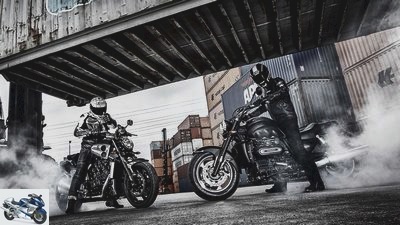
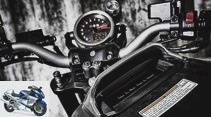
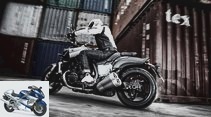
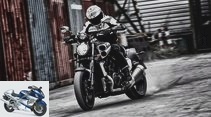

23 photos
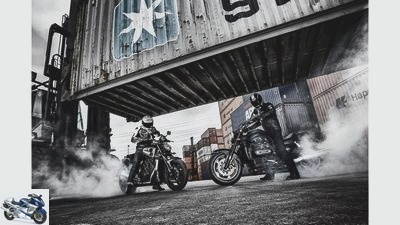
1/23
Triumph Rocket III Roadster and Yamaha Vmax. The displacement giants in the comparison test.
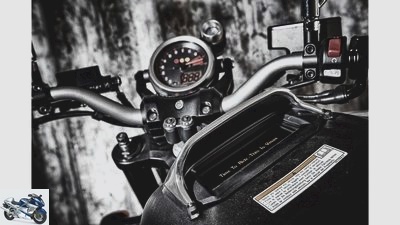
2/23
Yamaha Vmax – Martial appearance, posh workmanship, great details: at over 23,000 euros, the Vmax is an expensive but also very exclusive pleasure. And a classic of tomorrow today.
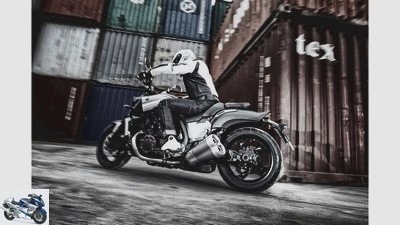
3/23
Yamaha Vmax.
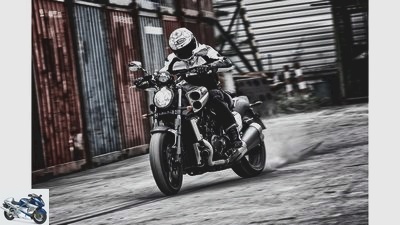
4/23
Yamaha Vmax – The transverse driver: Whoever plays with the clutch reaps a spinning rear wheel and courageous drift angles. And thanks to the large speed reserve over a fairly long distance. open fire!
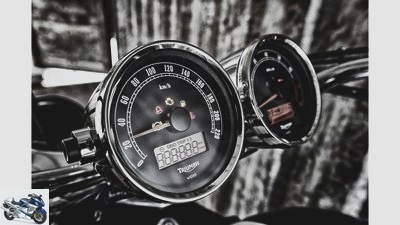
5/23
Triumph Rocket III – 2.3 liter displacement, 370 kilograms and everything a little bigger: With the Rocket you get a lot of motorcycle for the money for a good 17,000 euros. And a unique driving experience on top of that. Just try it out.
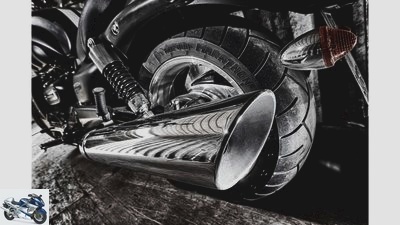
6/23
Triumph Rocket III – 2.3 liter displacement, 370 kilograms and everything a little bigger: With the Rocket you get a lot of motorcycle for the money for a good 17,000 euros. And a unique driving experience on top of that. Just try it out.
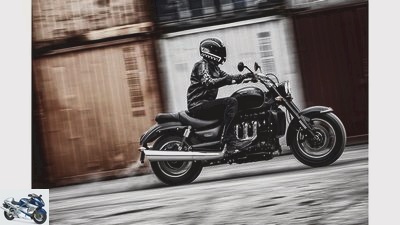
7/23
Triumph Rocket III – The torque giant: If the pad is not too grippy, a twist of the throttle is enough and the Rocket III Roadster rubs its rear tire on. In doing so, she remains calmly on track and storms forward with power.
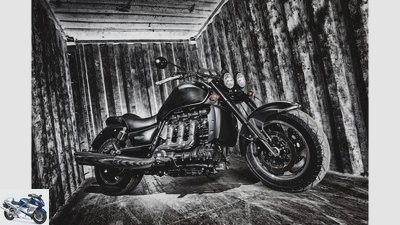
8/23
Triumph Rocket III – The British Way: double headlights, a fat engine, fat wheels, lots of metal. And a seating position made for power cruising.
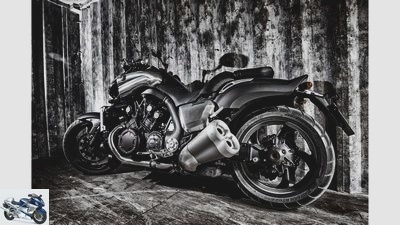
9/23
Yamaha Vmax – Nippon’s coolest piece: An assembled powerhouse in an extroverted form – actually too good to drive.

10/23
Triumph Rocket III.
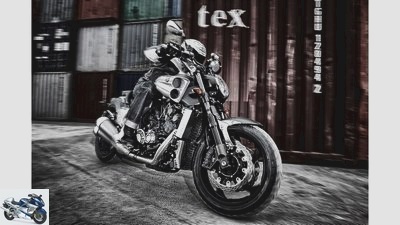
11/23
Yamaha Vmax.
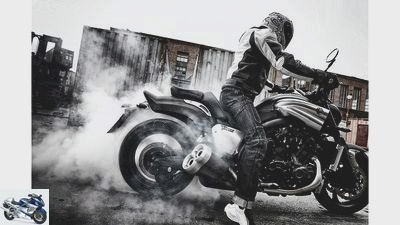
12/23
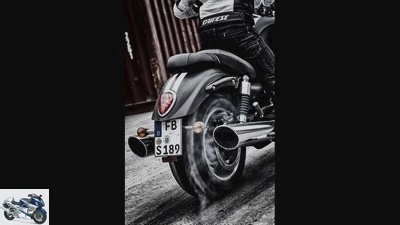
13/23

14/23
Triumph Rocket III Roadster and Yamaha Vmax. The displacement giants in the comparison test.

15/23
Heavy boxes: The right backdrop for two mighty motorcycles.
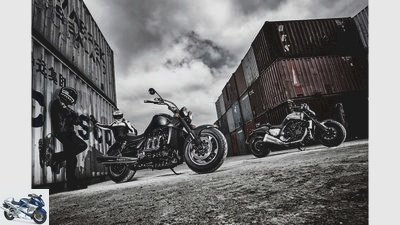
16/23
Triumph Rocket III Roadster and Yamaha Vmax. The displacement giants in the comparison test.
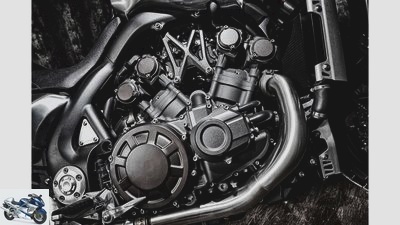
17/23
Yamaha Vmax – This is also unique in the motorcycle world: 1700 V4 with everything your heart desires, perfectly embedded in an aluminum bridge frame and beautifully finished.
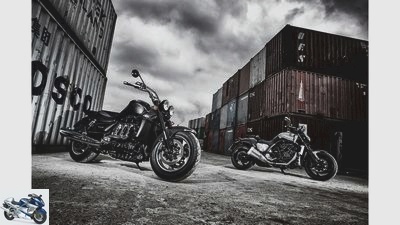
18/23
Triumph Rocket III Roadster and Yamaha Vmax. The displacement giants in the comparison test.
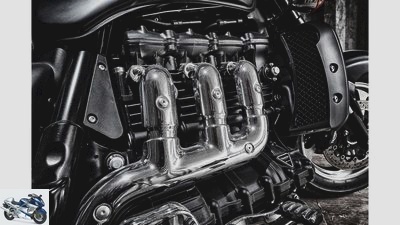
19/23
Triumph Rocket III: There is only one – at least in the motorcycle world: in-line three-cylinder, installed lengthways, four valves per cylinder, with individual displacement of 765 cubic centimeters – now everything in black.
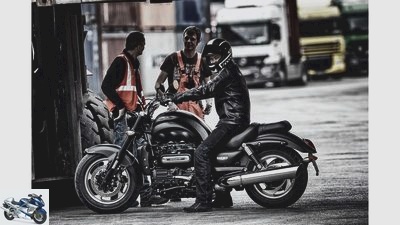
20/23
Triumph Rocket III.

21/23
Power plants: displacement giant and monster V4.
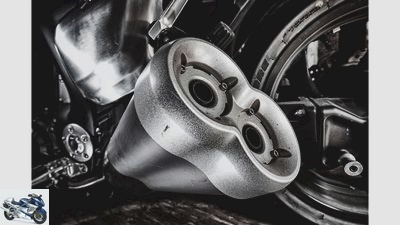
22/23
Yamaha Vmax – Martial appearance, posh workmanship, great details: at over 23,000 euros, the Vmax is an expensive but also very exclusive pleasure. And a classic of tomorrow today.

23/23
Triumph Rocket III Roadster and Yamaha Vmax in the test
Motorcycles with a large displacement in a comparison test
Triumph Rocket III Roadster and Yamaha Vmax: That means brute force in perfect choreography and impressive staging. But also a hot fight with the forces that are pulling them away.
There are people who cannot do anything with these topics. They make motorcycles as big, strong and heavy as a Triumph R.ocket III Roadster or a Yamaha Vmax a wide arc.
Buy complete article

Triumph Rocket III Roadster and Yamaha Vmax in the test
Motorcycles with a large displacement in a comparison test
First drive off, then strike
Triumph Rocket III – The torque giant: If the pad is not too grippy, a twist of the throttle is enough and the Rocket III Roadster rubs its rear tire on. In doing so, she remains calmly on track and storms forward with power.
“Friends”, one would like to call out to these contemporaries, “are you still with consolation! Can’t you imagine what these first-rate combustion engines would do with your fiddly lightweight devices? Do you think there is no reason for cardan shafts as thick as an arm and wheelbases between which a single family house has space? Folks, what pushes between front and rear wheel in these orgies of violence that have become metal has nothing to do with your hyperventilating barrel organs, but goes beyond all common motorcycle dimensions. Just take the Triumph once: 2.3 liter displacement, distributed over three cylinders, over 200 Newton meters at 2200 rpm – you only have a rough idea of what that means?
One breath of this motor monument is probably enough to tear your fifty-five O-ring chains into 1000 pieces practically from a standing start and twist every eighty-fifteen cardan into a corkscrew. Or take the V4 of the Vmax: almost 1700 cubic centimeters, which not only push like hell at the bottom, but also really tear at the top. Nominal 200 hp! But not at 14,000 / min, just before the valves and pistons go into the final meltdown, but 5000 / min earlier, at a wholesome 9,000 / min. Any questions? Such a monster would immediately put your racer upright if it really starts at 4000 rpm. Or occupy yourself with the wheelie control of your high-tech racer while trying to sprint up to Saint Never’s Day without moving from the spot. Then such a lightweight superbike just twitches like mad cow, while the fat Vmax marches off under smoke and smoke and the smell of burnt rubber. “
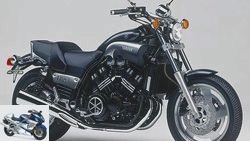
Used purchase
Second-hand advice Yamaha Vmax (1985 – 2010)
The Yamaha muscle bike as a used one
read more
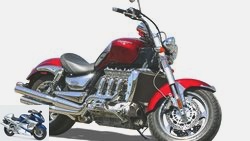
Used purchase
Used advice Triumph Rocket III
The used Triumph cruiser
read more
Of these two boom, the Vmax is the arsonist
Yamaha Vmax – The transverse driver: Anyone who plays with the clutch reaps a spinning rear wheel and courageous drift angles. And thanks to the large speed reserve over a fairly long distance. open fire!
So much for polemics. Now for the facts. What Triumph did was right. Out with this scourge called performance limitation, into full life. From now on, even in the first three gears, the full torrent of torque pours over the mighty crankshaft, practically from idle. With a small blemish, because on the MOTORRAD test bench it is not possible to demonstrate exactly what is actually accumulating deep in the crankcase or on the rear wheel of the Rocket, because this torque monster generates so much slip even in third gear on the test bench roller that the Values deviate significantly downwards, while in gears four and five the speed cutter still engages and regulates moderately at higher speeds. At 193 km / h it is over.
Therefore, the assumption must remain that the three-cylinder of the test motorcycle is a bit far from what the British promise us in the brochure. 203 Newton meters instead of 221, 131 HP instead of the advised 148 horses, that’s all we can attest to in terms of objective measured values. But we can calm down. As irresistible as the 370 kilogram stretch pushes towards the horizon at 25 Newton meters less – that is a very this-worldly experience even without the guarantee of mountains of torque on the other side, because the difference to the previous engine, which was throttled in the first three gears, is also considerable . Around 25 Newton meters more are now attacking. In abstract terms, this makes the unusual relationship between hardly increasing engine speed and rapidly increasing speed even greater. Popularly speaking, the Rocket now walks even more like a pig. A slight turn of the thick throttle is enough. High speeds – i.e. anything beyond 3500 rpm – or even clutch gimmicks are not required for this.
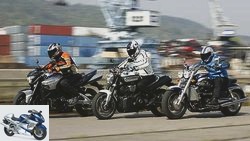
Naked bike
Comparison test Suzuki B-King, Yamaha MT-01 and Triumph Rocket III
Displacement and performance monsters
read more
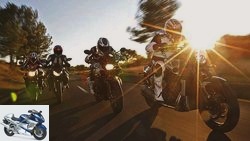
motorcycles
Comparison test BMW K 1300 R, Buell 1125 CR, Suzuki B-King, Yamaha Vmax
Big bikes
read more
Your favorite discipline is called “full throttle”
Power plants: displacement giant and monster V4.
Seen in this way, the Vmax full steam ahead strategy is clearly more conventional, but by no means less violent. First drive off, then strike – that is the motto of one of the undoubtedly most fascinating drives in motorcycle history. If you look at the curve on the right, you will understand why. No other engine has ever approached the 200 hp barrier in such a linear and purposeful manner. And no high-performance engine has ever been packaged so martially. The four-valve engine is compact, almost concentrated, in the tight frame corset of the exquisitely processed aluminum bridge frame, where the mighty Triumph block hangs heavy and massive under the plain steel backbone of the Rocket. The Vmax provocatively sucks in cubic meters of air through obviously raised nostrils made of brushed aluminum, where the British triple snorkels cautiously under the wide tank fairing. And the four exhaust bags nestle boldly around the 200cc rear wheel, where the conventional, eternally long Triumph bags keep a respectable distance.
There is no question: of these two booming hums, the Vmax is the arsonist, and not just visually. If you want to know what that means: Just let the clutch slip at a little speed. Then it whistles, whimpers and smokes – and the Vmax draws the boldest black lines you can imagine. If need be, up to the horizon, because the powerful thrust of the V4 just doesn’t stop. In addition, there is a background noise that is addicting, because this mixture of deep displacement bass and high speed is not available anywhere in the world.
MOTORCYCLE market: Used Triumph Rocket III Roadster
MOTORCYCLE market: Used Yamaha Vmax




18th photos
Pictures: Triumph Rocket III Roadster and Yamaha Vmax in the test
To home page

Gargolov
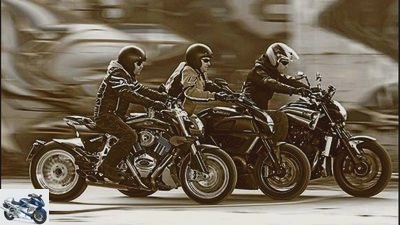
Gargolov
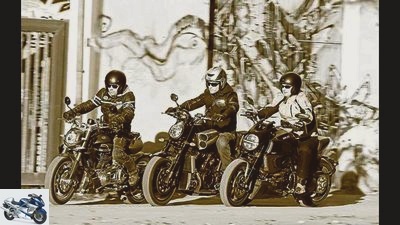
Gargolov
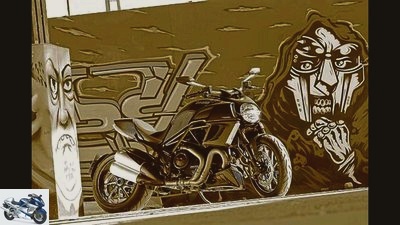
Gargolov
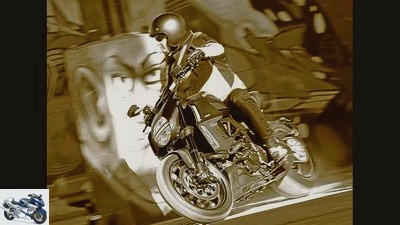
Gargolov
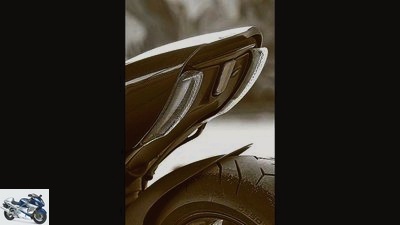
Gargolov
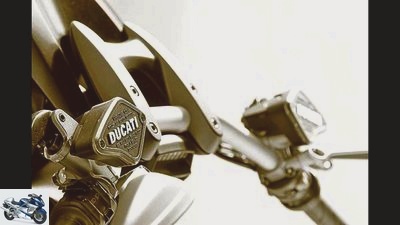
Gargolov
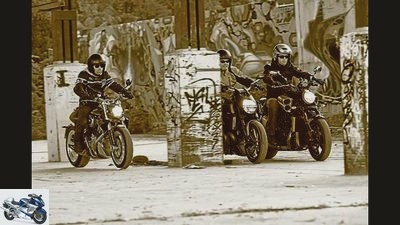
Gargolov
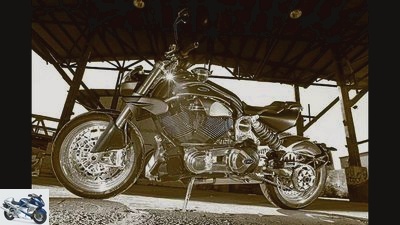
Gargolov
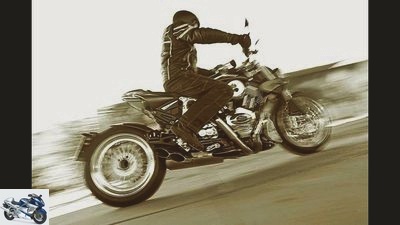
Gargolov
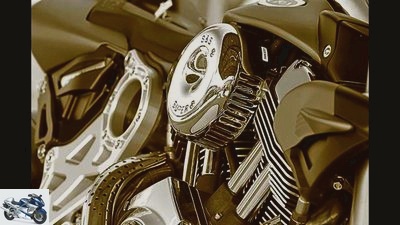
Gargolov
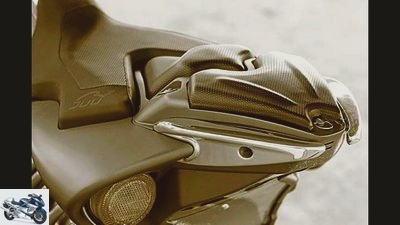
Gargolov
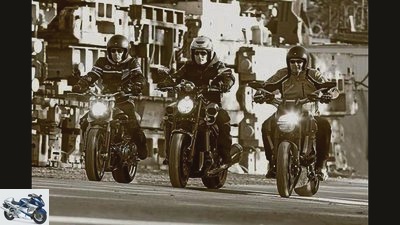
Gargolov
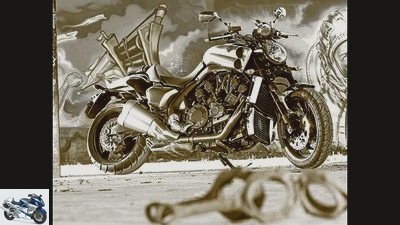
Gargolov
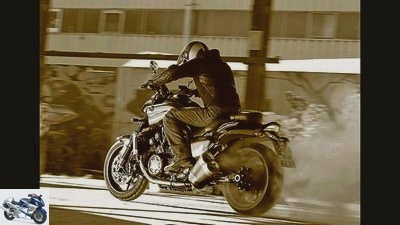
Gargolov
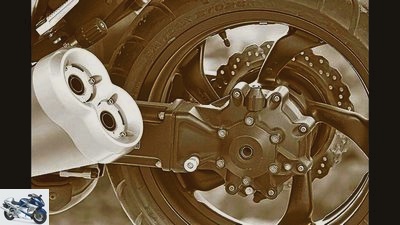
Gargolov
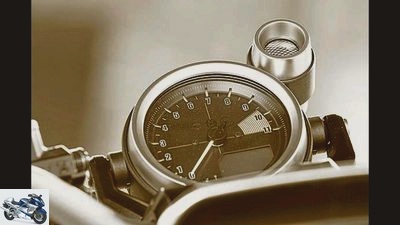
Gargolov

Gargolov
At the top, however, the fat roadster noticeably runs out of air compared to the muscle man Vmax, but then the lack of power and the high weight become noticeable, while the Yamaha just keeps going. Up to 200 km / h you practically do not drive a superbike before the poor aerodynamics, but above all your speed cutter, set limits at 220 things. But such tempo orgies, despite their name, are by no means the determination of the Vmax, although such things can be endured much better behind the narrow and flat handlebars than behind the broad antlers of the Rocket III.

Tourer
Triumph Rocket III Roadster in the test
Gigantic, powerful, strong as a bear
read more
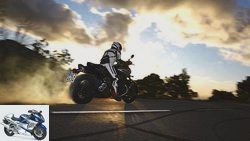
Naked bike
Test Yamaha Vmax
200 hp monster bike
read more




15th photos
Pictures: Triumph Rocket III Roadster and Yamaha Vmax in the test
To home page

Jahn
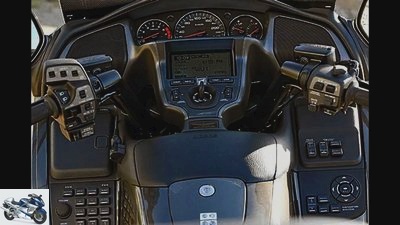
Jahn
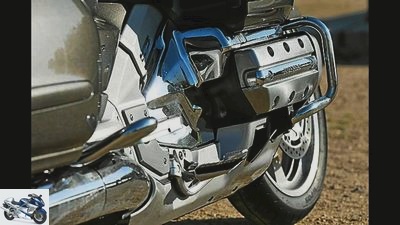
Jahn
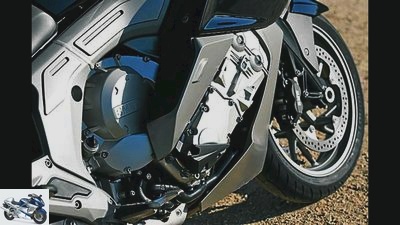
Jahn
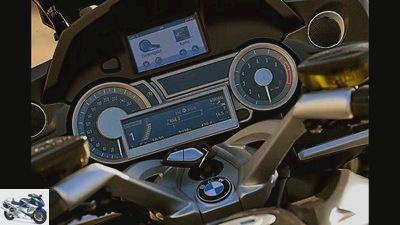
Jahn
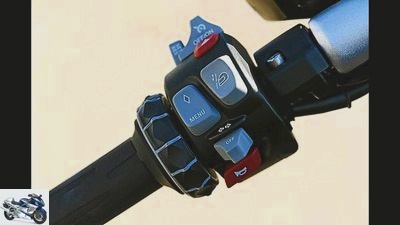
Jahn
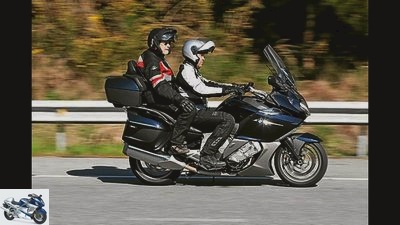
Jahn
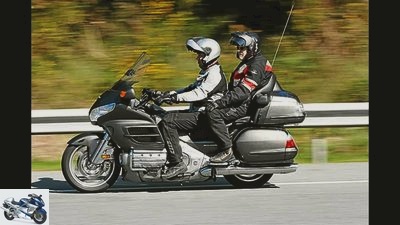
Jahn
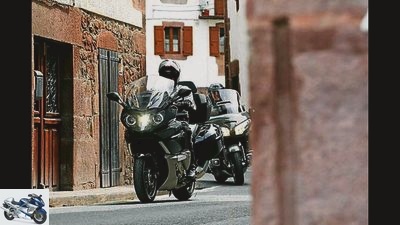
Jahn

Jahn
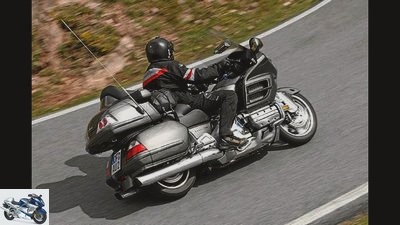
Jahn
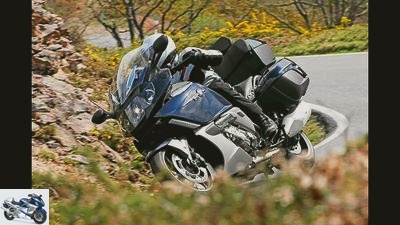
Jahn
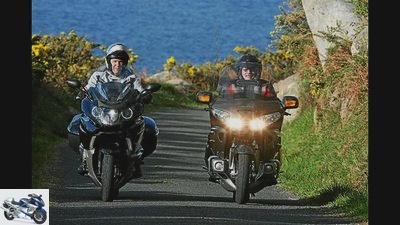
Jahn
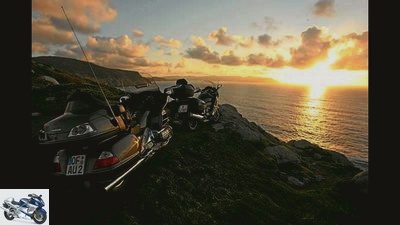
Jahn

Jahn
Torque
archive
Torque measurement: Diagram: measurements on the Dynojet roller test stand 250, corrected according to 95/1 / EC, maximum possible deviation ± 5.
How much is there – and especially where? These are the crucial questions when it comes to torque. The rocket threesome can now show what it’s made of in third gear.
The current motorcycle world does not offer anything comparable again, and you stand in awe in front of the mountain of torque that the three-cylinder piles up practically from idle. Indeed, in this regard, the V4 has nothing to report to the Vmax. On the contrary: it starts rather cautiously, even allowing itself a little hitch between 3000 and 4000 rpm before it really gets down to business. Subjectively, this performance characteristic can also be experienced, the displacement giant the Triumph develops noticeably more pressure. Adjusted for the translation, however (see pull-through table below), the Vmax gets going even more powerfully than the Rocket III and, the higher the pace, the more meters it decreases. The English triplet counteracts this with its marine diesel character – and hums quite calmly.
| triumph | Yamaha | |
| 50-100 km / h | 2.8 sec | 2.3 sec |
| 100-150 km / h | 3.6 sec | 2.3 sec |
Clear point victory for the Vmax. Despite the torque disadvantage, it pulls through significantly better in third gear than the Rocket III Roadster.
Power on the crankshaft
archive
Power measurement (crankshaft): The Rocket pushes enormously from the very bottom, but only unwillingly turns over 5000 rpm, the Vmax delivers power anytime and anywhere and turns easily up to the five-digit range. Measurements on the Dynojet roller test stand 250, corrected according to 95/1 / EG, maximum possible deviation ± 5.
The power on the crankshaft (measured in third gear) reflects what the engine is capable of, in relation to the speed.
Aha, the displacement advantage, one would like to say. And he is right, because logically the large three-cylinder rocket also draws more power from its 500 cubic centimeter larger displacement at the same speed. However, this advantage is not very big, because the liter output of the triple is at 57 hp in a manageable range. For comparison: the liter output of the Yamaha V4 is almost twice as high with 110 hp. So it’s no wonder that from a good 6000 rpm the Vmax engine pulls away unassailable, while the fat Triumph chunk has reached the end of its revving power.

motorcycles
Behind the scenes of the 1000-point evaluation
Special: This is how MOTORRAD tests
read more
Performance on the rear wheel
archive
Diagram: performance on the rear wheel. Measurements on the Dynojet roller test stand 250, corrected according to 95/1 / EG, maximum possible deviation ± 5%.
The decisive factor when it comes to driving performance, because the ratio (third gear) is also included here. Therefore, the curves here sometimes shift considerably.
It is always exciting to compare the “common” performance curves, which represent the performance of the engine on the crankshaft, with the performance curves on the rear wheel. In the case of the Rocket III Roadster and Yamaha Vmax, this means: The considerable lead that the British triple had up to almost 6000 rpm on the crankshaft is or is eaten up by the longer ratio of the Rocket (in order to achieve a corresponding top speed at a much lower speed) turns into the opposite.
In plain language this means: up to 80 km / h, roughly the same amount of power arrives at the rear wheel, after which the Vmax pulls away unreachable. If you add the additional weight of the Triumph, the better driving performance of the Yamaha is almost self-explanatory. But the fact is: the Vmax has to turn significantly higher.
| triumph | Yamaha | |
| 0-100 km / h | 3.5 sec | 2.7 sec |
| 0-140 km / h | 6.3 sec | 4.4 sec |
| 0-200 km / h | – | 8.3 sec |
The domain of the Vmax is its brute acceleration. It beats the Rocket III Roadster in all respects and easily reaches the 200 km / h mark.
Technical specifications
Heavy boxes: The right backdrop for two mighty motorcycles.
| Triumph Rocket III | Yamaha Vmax | |
| Type of engine | Three-cylinder four-stroke in-line engine, two overhead, chain driven camshafts, four valves per cylinder, Bucket tappets, dry sump lubrication |
Four cylinder four stroke 65 degree V engine, two overhead, gear / chain driven camshafts, four valves per cylinder, Bucket tappets, wet sump lubrication |
Mixture preparation | Injection, Ø 52 mm | Injection, Ø 48 mm |
| coupling | Multi-disc oil bath clutch | Multi-disc oil bath clutch (anti-hopping) | transmission | Five-speed | Five-speed |
| Secondary drive | Cardan | Cardan | Bore x stroke | 101.6 x 94.3 mm | 90.0 x 66.0 mm |
| Displacement | 2294 cm3 | 1680 cm3 | compression | 8.7: 1 | 11.3: 1 |
| power | 108.8 kW (148 hp) at 5750 rpm | 147.2 kW (200 PS) at 9000 rpm | Torque | 221 Nm at 3250 rpm | 167 Nm at 6500 rpm |
| Weight with a full tank | 370 kg | 315 kg | Front / rear wheel load distribution | 169/201 kg | 157/158 kg |
| Top speed | 193 km / h | 220 km / h | consumption | 7.0 liters | 8.0 liters |
| Range | 343 | 188 km | Price without additional costs | 17 390 euros | 23 495 euros |
Related articles
-
Comparison test Suzuki B-King, Yamaha MT-01 and Triumph Rocket III
fact 15 pictures artist 1/15 artist 2/15 artist 3/15 artist 4/15 artist 5/15 artist 6/15 artist 7/15 artist 8/15 artist 9/15 artist 10/15 artist …
-
Single test: Triumph Rocket III Roadster
fact Triumph Rocket III Roadster in the test Gigantic, mighty, strong as a bear Maximum displacement on two wheels makes the Triumph Rocket III the boss in the ring ….
-
Naked bikes from Ducati, Triumph and Yamaha put to the test
32 pictures 1/32 Ducati Streetfighter S / Streetfighter 848, Triumph Speed Triple R / Street Triple R and Yamaha FZ1 / FZ8 in …
-
Test: Triumph Rocket III Roadster
Bilski Test: triumph Triumph Rocket III Roadster More power, more torque, better brakes and a more martial appearance for less money: The Triumph press…
-
Suzuki Hayabusa, Kawasaki Ninja H2, Aprilia RSV4 RF and Yamaha Vmax in the test
Bilski 41 photos Bilski 1/41 Yamaha Vmax, Suzuki Hayabusa, Aprilia RSV4 RF, Kawasaki Ninja H2. Each of these four machines has its own special charm….
-
Comparison test: Honda CB 1000 R, Yamaha FZ1, Triumph Speed Triple, Kawasaki Z 1000
Comparison test: Honda CB 1000 R, Yamaha FZ1, Triumph Speed Triple, Kawasaki Z 1000 Large naked bikes in comparison Contents of …
-
Comparison test: Ducati Diavel, Suzuki B-King and Yamaha Vmax
Jahn comparison test: Power Bikes 2011 Ducati Diavel, Suzuki B-King and Yamaha Vmax Content from Big appearance, powerful sound waves, pressure from all …
-
Ducati XDiavel S, Harley-Davidson V-Rod Muscle and Yamaha Vmax in comparison test
26 pictures 1/26 Harley-Davidson V-Rod Muscle, Yamaha Vmax and the new Ducati XDiavel S tested on the drag strip. …
-
BMW, Kawasaki, Triumph and Yamaha Tourer in comparison test
Gargolov 31 pictures Gargolov 1/31 Tourer comparison test: Triumph Trophy SE, BMW R 1200 RT, BMW K 1600 GT, Yamaha FJR 1300 and Kawasaki 1400 GT. Gargolov …
-
Artist 38 photos Artist 1/38 …and has to be careful that he does not get sick with constant changes of lean angle. Artist 2/38 The machine comes…